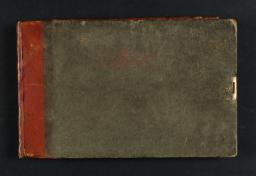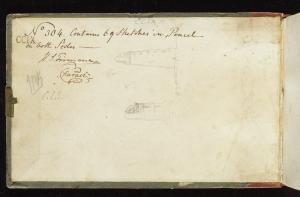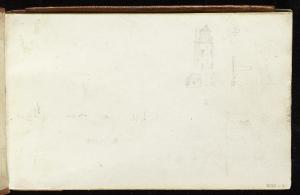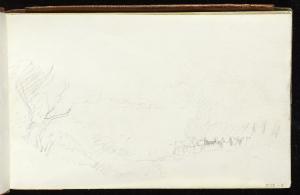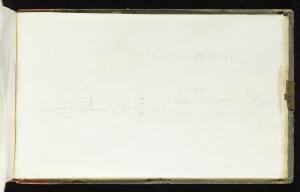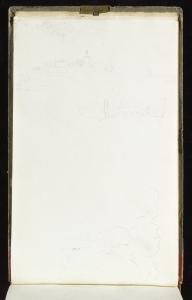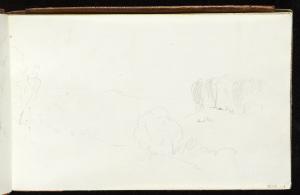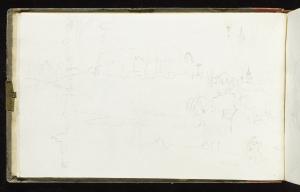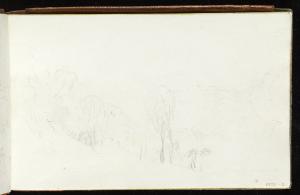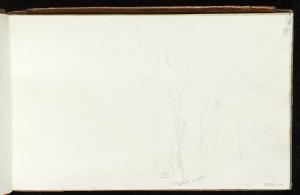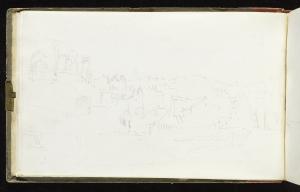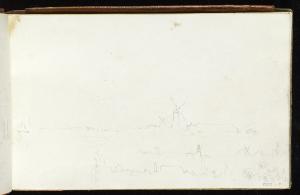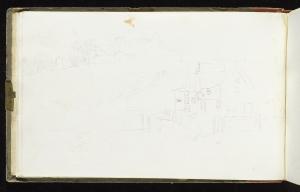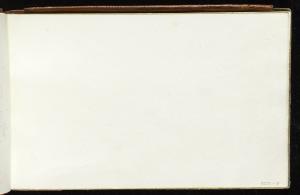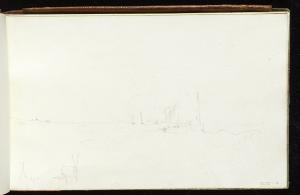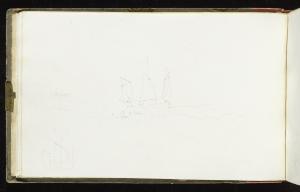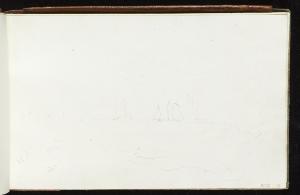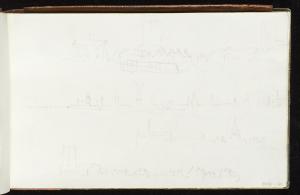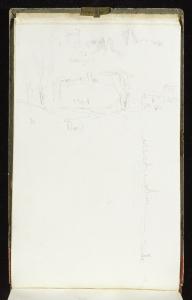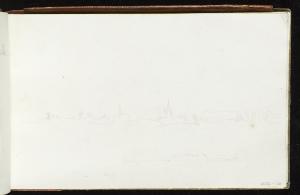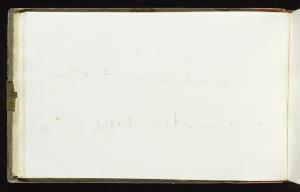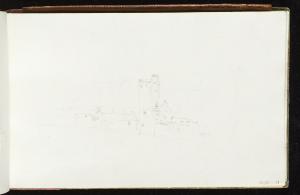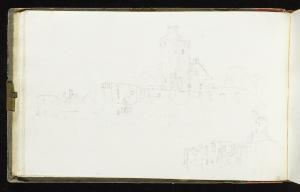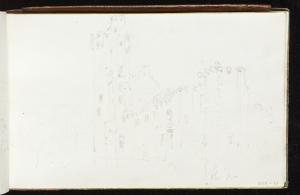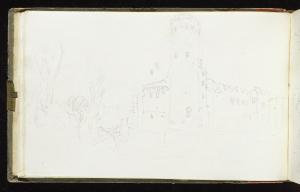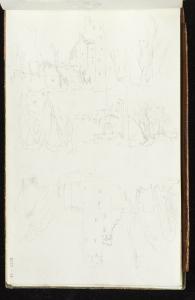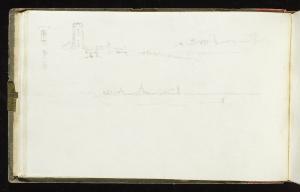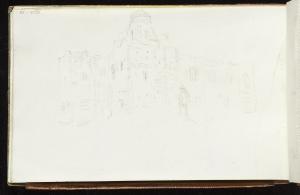Turner Bequest CCIX 1–89a
Sketchbook half-bound with dark grey boards and tan leather spine
Remains of brass clasp on front and back covers and tan leather pencil holder attached to head of back cover
Inscribed by Turner in red ink ‘Essex’ on front cover
Signed and inscribed in black ink by Henry Scott Trimmer ‘No 304. Contains 69 Sketches in Pencil | on both Sides –’ and Charles Turner on pastedown of inside front cover
Signed in pencil by John Prescott Knight ‘JPK’ and Charles Locke Eastlake ‘C.L.E.’ on pastedown of inside front cover
Blind-stamped with Turner Bequest monogram centre towards top left of pastedown of inside front cover, on spine of front cover at top, and on front cover at centre left
Inscribed in pencil ‘CCIX’, ‘5. 70’ at top centre of pastedown of inside front cover
Stamped in black ‘CCIX’ top right of front cover
Inscribed in pencil ‘CCIX’ on spine of front cover (top)
89 pages of white wove paper
Watermarked ‘allee | 1819’
Approximate size of page 115 x 118 mm
Remains of brass clasp on front and back covers and tan leather pencil holder attached to head of back cover
Inscribed by Turner in red ink ‘Essex’ on front cover
Signed and inscribed in black ink by Henry Scott Trimmer ‘No 304. Contains 69 Sketches in Pencil | on both Sides –’ and Charles Turner on pastedown of inside front cover
Signed in pencil by John Prescott Knight ‘JPK’ and Charles Locke Eastlake ‘C.L.E.’ on pastedown of inside front cover
Blind-stamped with Turner Bequest monogram centre towards top left of pastedown of inside front cover, on spine of front cover at top, and on front cover at centre left
Inscribed in pencil ‘CCIX’, ‘5. 70’ at top centre of pastedown of inside front cover
Stamped in black ‘CCIX’ top right of front cover
Inscribed in pencil ‘CCIX’ on spine of front cover (top)
89 pages of white wove paper
Watermarked ‘allee | 1819’
Approximate size of page 115 x 118 mm
Accepted by the nation as part of the Turner Bequest 1856
Exhibition history
References
The drawings in this eighty-nine-page sketchbook represent a tour of the Norfolk and Suffolk coast, with a group of views showing Colchester in Essex. Turner inscribed ‘Essex’ in pen and red ink on the front cover of the book, yet very little else of the county is depicted other than that historic city. Turner is believed to have employed the Norfolk, Suffolk and Essex sketchbook in the summer of 1824, though scholars have not yet been able to determine specific timeframes for its use. The Turner historian Andrew Wilton places the artist’s short tour of these counties after May, when the Battle of Trafalgar (1822–4, National Maritime Museum, Greenwich) had just been hung in St James’s Palace, and before Turner’s extensive tour of the Meuse, Moselle and Rhine rivers, which took place between 10 August and 15 September.1
Turner presumably moved up the Suffolk coast from Colchester, which, by 1824, was connected to London via good roads and stagecoach services.2 For a time the capital of Roman Britain, Colchester is known for its largely complete Norman castle, which itself is constructed on the foundations of an earlier temple dedicated to Claudius.3 William the Conqueror ordered Colchester Castle in about 1076, recognising the value of building a stronghold at this strategic location near England’s metropolis and the North Sea coast.4 Turner focused on recording the Castle and the River Colne during his short stint at the city, but also produced prospects taken from further afield in the surrounding hillside (Tate D18160–D18161, D18163–D18169, D18171, D18274–D18276, D18286, D18296–D18298; Turner Bequest CCIX 1a–2, 3–6a, 7a, 60a–62, 71, 80a–81a). Some of these drawings were developed into a design for the Picturesque Views in England and Wales print publication project, to which Turner contributed from late 1824 to early 1836.5 Turner’s Colchester, Essex (Courtauld Institute Gallery, London) was produced a year or two later and was published by Charles Heath as an engraved print in 1827 (Tate impression T04512).6
Orford on the Suffolk coast was Turner’s next destination. The artist sketched Orford’s lighthouse, haven, medieval castle, and the long shingle spit located at the mouth of the Ore called Orfordness (Tate D41438, D18159, D18162, D18237, D18238, D18304–D18309; Turner Bequest CCIX 1, 2a, 41a, 42, 86a–89). As with the sketches of Colchester, these drawings were elaborated to form the watercolor Orford, Suffolk, published by Heath for the England and Wales scheme in 1827 (Tate impressions T04523–T04524).
One other design was produced from the Orford sketches for a different, and ultimately unsuccessful, engraving project. This was the gouache vignette on blue paper entitled Orford Castle and Church, executed in around 1827 (Indianapolis Museum of Art). Made as part of a set of three vignettes, each produced using the same media and in the same format, Orford Castle and Church and its companions Lowestoft Lighthouse (Indianapolis Museum of Art and Harborough Sands (private collection) are associated with what is now called the Picturesque Views on the East Coast of England engraving series.7 In his 1990 publication the Turner scholar Eric Shanes added a fourth to the vignette group: Great Yarmouth Fishing Boats (Stirling and Francine Clark Institute, Williamstown, Massachusetts), arguing that the work’s ‘circular shape, subject and support all clearly indicate that it was made for the “East Coast” scheme’.8 The vignettes were grouped with five other rectangular watercolour on blue paper drawings depicting Aldeborough, Suffolk, Dunwich, Orfordness, Lowestoffe and Whitby. 9 Wilton also places a watercolour of Yarmouth Sands (Fitzwilliam Museum, Cambridge) and a second watercolour of Whitby (Private Collection) in this latter group.10 J.C. Allen, an engraver who had worked on W.B. Cooke’s Southern Coast scheme, engraved all of the views, apart from Lowestoffe and Whitby which remained as open etchings only. The vignette Great Yarmouth Fishing Boats, the rectangular watercolour of Yarmouth Sands and the second design for Whitby were not engraved. None of the designs was published.
The instigation and purpose of the East Coast project is open to some speculation. Eric Shanes proposes that Turner initiated it in around 1827 ‘following the failure to agree terms with the Cooke brothers in late 1826 for their East coast continuation of the Picturesque Views of the Southern Coast scheme’.11 Owing to the souring of relations between Turner and the Cookes this section of the scheme was abandoned, despite the majority of the drawings having been already engraved by J.C. Allen.12
The drawings have alternatively been referred to as ‘the Supplement to England and Wales’ (i.e. Charles Heath’s Picturesque Views in England and Wales), though this is ultimately a misleading categorisation. It appears to have come about because of the inclusion of the East Coast drawings and plates in a list of Turner’s engraved works compiled by Charles Stokes (1785–1853), the artist’s friend. Stokes’s list, published in abbreviated form by Walter Thornbury, shows that eight of the East Coast subjects are listed under the heading ‘Published by Holloway for the England and Wales’.13 Holloway was a printmaker who purchased the East Coast drawings and J.C. Allen’s engraved copperplates of them some years after Turner’s death. He published an edition from the plates, but was wholly unaware of Turner’s original intentions for them. He later confirmed to W.G. Rawlinson that he had:
no idea by whom they were originally commissioned, or for what purpose they were intended, nor had he ever contemplated issuing them as a “Continuation of ‘England and Wales’”.14
no idea by whom they were originally commissioned, or for what purpose they were intended, nor had he ever contemplated issuing them as a “Continuation of ‘England and Wales’”.14
Holloway’s impressions failed to find buyers and he soon sold the drawings. Owing to the marked difference in size and style between the East Coast designs and the England and Wales, both Rawlinson and Andrew Wilton agree that the former are unrelated to the latter.15
One final possibility, though still speculative, is that the gouaches were connected to a proposed illustrated edition of the poetical works of the Reverend George Crabbe. The gouache vignette of Orford Castle and Church (Indianapolis Museum of Art) and its companion Lowestoffe Lighthouse (same collection) were catalogued in the collection of H.A.J. Munro of Novar as ‘Two Illustrations to Crabbe’.16 Crabbe was a native of Aldeborough (one of the eight subjects) and wrote extensively on the east coast of England and its fishermen. Jan Piggott, in his 1993 catalogue Turner’s Vignettes, notes that Turner was working extensively with the engraver E.F. Finden and publisher J.S. Murray around the time that their illustrated version of Crabbe’s Poetical Works was published in 1834, though there is no evidence in Murray’s account books to corroborate Turner’s commissioned involvement in this project.17
The purpose of the East Coast drawings and their engraved plates, then, remains somewhat of a mystery. Turner, it should be reiterated, ‘was the last man to spend time and money without an object’, and there can be no doubt that a plan existed to publish prints within an isolated scheme or one annexed to an active project.
From Orford Turner’s tour continued to Aldebrugh, a town situated a little further north on the Suffolk coast on the River Alde (Tate D18266–D18272, D18299; Turner Bequest CCIX 56–59a, 82). Designs for the England and Wales series and the East Coast developed from some of these drawings (Tate Gallery, London, Tate impressions T04521–T04522, and Private Collection).18 The village of Dunwich followed Aldebrugh on the coastal route. Dunwich had been a major township in the Anglo-Saxon period, but owing to its precarious location so close to the North Sea violent storms and coastal erosion diminished the town considerably. Turner’s sketches show one of Dunwich’s ancient churches, then positioned at the cliff’s edge and now almost entirely lost to the sea. All Saints’ Church was abandoned in the mid eighteenth century because of the mounting costs in upkeep and over time, as the building decayed and erosion weathered away more and more of the coastline, great masses of it collapsed into the North Sea.19 From Turner’s sketches of All Saints and this stretch of battered coast emerged the watercolour Dunwich (City Art Gallery, Manchester) for the East Coast scheme (Tate impression T04613).20
Passing by Walberswick and Southwold (Tate D18252, D18256, D18260–D18263, D18310, D41439; Turner Bequest CCIX 49, 51, 53–54a, 89a), Turner’s next destination was the port town of Lowestoft. Its lighthouse, built in 1609, was of particular interest to the artist (Tate D41438, D18159, D18225–D18227, D18236, D18239–D18249; Turner Bequest CCIX 1, 35a–36a, 41, 42a–47a). A vignette and watercolour design for the East Coast series originated from these sketches (Indianapolis Museum of Art, Tate impression T06613, and Private Collection).21 Turner travelled north from Lowestoft, crossing the Suffolk border into Norfolk to sketch the thriving harbour of Yarmouth. A major fishing port celebrated for its herrings or ‘silver darlings’, Turner produced a large number of sketches recording the life and labour at the quayside and in the market square (Tate D18170, D18173, D18176–D18224; Turner Bequest CCIX 7, 9, 11–35). He documented fishermen on the sands preparing the day’s catch, people promenading on the shore and boats moored on the beach. There are also studies of the Britannia Monument, a column built in 1817 to commemorate Admiral Horatio Nelson and his four main victories over the French and Spanish (Tate D18212; Turner Bequest CCIX 29), and nearby Caister Castle.22 Turner’s drawings resulted in three designs: a vignette and watercolour for East Coast project entitled Great Yarmouth Fishing Boats (Stirling and Francine Clark Institute, Williamstown, Massachusetts) and Yarmouth Sands (Fitzwilliam Museum, Cambridge) and finally a design for the England and Wales series called Great Yarmouth, Norfolk (currently untraced, Tate impressions T04546–T04547).23
Turner’s last stop on the tour was Happisburgh (pronounced ‘Haysborough’), a small fishing village on the Norfolk coast located about twenty miles north of Yarmouth. Happisburgh Sands are broad, golden but treacherous, and many lives have been lost navigating the waters there over centuries.24 The lighthouse built in 1791 as a consequence of these fatalities is the focal point of a vignette based on the drawings Turner took at Happisburgh (Tate D18228–D18233; Turner Bequest CCIX 37–39a).25
While little is understood of the inception and purpose of the East Coast tour, Turner’s drawings produced a small collection of important watercolour and vignette designs which stand apart from other schemes in their style, handling and format. With regard to subject, almost all of them feature fishermen in the foreground, navigating their vessels into the calm and placid waters of a harbour or wrestling turbulent currents in the open sea. These compositions communicate the preeminence and national significance of East Anglia’s fishing industry to the nineteenth-century and contemporary viewer, and of that industry’s pivotal role in the health of local communities like Orford or Lowestoft. Foregrounded in this way, a fishermen’s daily narrative is told. We see their toil, their nautical skill, the dangers of seafaring trades, the bounties of an abundant catch and the risk of a depleted haul.
For more information see Shani D’Cruze, A Pleasing Prospect: Society and Culture in Eighteenth-Century Colchester, Hertfordshire 2008.
‘History’, Colchester & Ipswich Museums, accessed 16 April 2015, http://www.cimuseums.org.uk/article/10838/History
For more information see Eric Shanes’s entry ‘The Picturesque Views in England and Wales’ in Evelyn Joll, Martin Butlin and Luke Herrmann (eds.), The Oxford Companion to J.M.W. Turner, Oxford 2001, pp.87–9.
Wilton 1979, p.405 under nos.896–898; see also W[illiam] G[eorge] Rawlinson, The Engraved Work of J.M.W. Turner, R.A., London 1908, vo.I, p.171 nos.305–7.
See Eric Shanes’ entry ‘The Picturesque Views in England and Wales’ in Joll, Butlin and Herrmann (eds.) 2001, p.87.
Walter Thornbury, The Life of J.M.W. Turner, R.A. Founded on Letters and Papers Furnished by his Friends and Fellow-Academicians, London 1862 [1861] , p.357.
William Frost (revised by Henry Reeve), A Complete Catalogue of the Paintings ... Drawings and Prints in the Collection of the Late Hugh Andrew Johstone Munro, Esq., of Novar, etc., London 1865, p.124 nos.120–22
‘Curiosities’, Norfolk Coast, accessed 17 April 2015, http://norfolkcoast.co.uk/curiosities/cu_britannia.htm
‘History’, Happisburgh Village, accessed 17 April 2015, http://www.happisburgh.org/history/sea/losses-at-sea
How to cite
Alice Rylance-Watson, ‘Norfolk, Suffolk and Essex sketchbook 1824’, sketchbook, March 2015, in David Blayney Brown (ed.), J.M.W. Turner: Sketchbooks, Drawings and Watercolours, Tate Research Publication, August 2016, https://www

